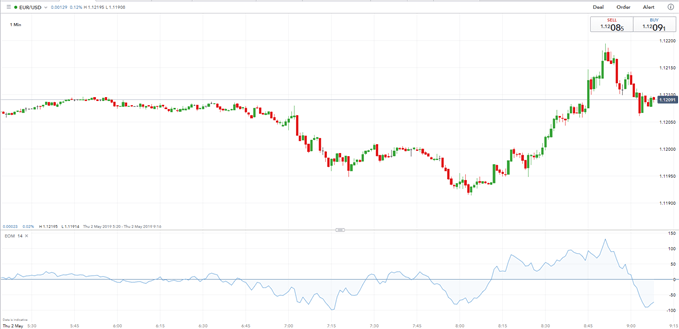EUR talking points
- EURUSD Fails to Rebound from Yesterday’s Losses
- Eurozone Manufacturing PMI Data
The Euro was regaining some support at the beginning of the morning session as an influx of European manufacturing PMIs (Spain, Italy & France) were coming in better than expected, but a downward revision for Germany halted its uptrend leaving the pair trading around the 1.1200 handle.
The focus for EURUSD traders will now shift towards tomorrow’s Eurozone Consumer Price Index, which may come in better than expected following the sizeable lift in German inflation figures (economic calendar).
EURUSD PRICE CHART: 1-minute Time-Frame (Intraday)

Manufacturing PMI Figures
Eurozone manufacturing PMI final figures for April came in better than expected at 47.9 (Exp. 47.8), up from 47.5 in March, seeing a small rebound after continuing declines since July 2018. The figure is the second lowest since April 2013 and as unemployment and growth remained stagnant, its influence on the ECB’s next rate decision is likely to be minimum.
Spain managed a second month of expansion as April manufacturing PMI was 51.8, whilst Italy managed to beat expectation of 47.7, with the final figure coming in at 49.1. France’s manufacturing services rose to 50 in the month of April, beating expectations of a contraction in the industry.
German manufacturing PMI final figures for April had been revised down to 44.4 from 44.5, while this is slightly up from the 80-month low of 44.1 in March, this continues to show that the manufacturing sector remains very much in contraction territory. This is believed to be driven mostly by the weaker demand across the automotive sector leading to a steep decline in new export orders.
The disappointing figure comes after the recent German CPI for April released earlier this week, which showed that headline inflation jumped to 2% above expectations of 1.5%. The increase is said to be due to higher prices for energy and services, with the latter most likely experiencing a boost from the Easter holiday period. Nonetheless, a decrease in unemployment figures show that the uptrend in inflation may continue in the following months.
IG Client Sentiment – Retail trader data shows 67.4% of traders are net-long with the ratio of traders long to short at 2.07 to 1. In fact, traders have remained net-long since Apr 12 when EURUSD traded near 1.12763; price has moved 0.9% lower since then. The number of traders net-long is 0.5% lower than yesterday and 14.7% higher from last week, while the number of traders net-short is 9.2% higher than yesterday and 20.4% lower from last week.
We typically take a contrarian view to crowd sentiment, and the fact traders are net-long suggests EURUSD prices may continue to fall. Positioning is less net-long than yesterday but more net-long from last week. The combination of current sentiment and recent changes gives us a further mixed EURUSD trading bias.
Recommended Reading
EURUSD Weekly Technical Outlook: Euro May Bounce, but Buyer Beware – Paul Robinson, Currency Strategist
Eurozone Debt Crisis: How to Trade Future Disasters – Martin Essex, MSTA, Analyst and Editor
KEY TRADING RESOURCES:
- Just getting started? See our beginners’ guide for FX traders
- Having trouble with your strategy? Here’s the #1 mistake that traders make
- See our Q1 forecasts to learn what will drive FX the through the quarter.
--- Written by Daniela Sabin Hathorn, Junior Analyst






